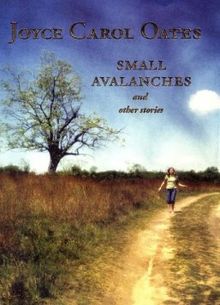A Short Pitch for Exquisite Short Stories
Patricia A. Dunn
Unlike novels, short stories can easily be read several times--even during class time--with the second or third go-round showing us how the author did so much so quickly. This careful reading can help students practice the close analysis we ask them to do in English classes. A number of older YA short stories are available online for free these days, making it possible to project passages during class time so that we are all examining the same page.
In contrast, short fiction writers have little time to set the scene, make us care about the protagonist, dramatize the conflict(s), and wrap things up by the end--or not, if it’s a deliberately ambiguous ending or a slice-of-life story. A great short story can draw you in, spin you around, and return you--changed--to your own life, and all in one sitting.
| That is why, on the first day of my introductory young adult or other literature classes, before we even get to the syllabus, we read Sharon G. Flake’s short story, “So I Ain’t No Good Girl,” from her 2004 collection, Who Am I Without Him? I’m always stunned by how the author does so much in less than 2000 words, placing us with the narrator in the opening paragraph on a bus corner in the midst of a teenage drama with the “good girls,” even as the first person narrator reveals her troubled relationship with her mother. After this scene, which doubles as the short but rich exposition, another problem enters the scene quickly, as we watch the narrator both question and then appease her abusive boyfriend. Alert readers will notice, however, another, deeper conflict: the one within the narrator herself. We see it, even if she does not: the decision about whether she should continue to endure abuse and keep her good looking boyfriend, Raheem, or stand up for herself and tell him to get lost. In fact, we see her beginning to think better of the bad bargain she has made with him, though just when we want to cheer her on in what might be an inkling to dump him, she capitulates again to please him. |
Flake’s story is a masterful example of an unsympathetic (at first), unreliable narrator, who reveals more to us than to herself what is going on in her life. It demands a rereading so that we can understand more fully the narrator’s thought process and how she succeeds in almost, but not quite, fooling herself. Perhaps we see more than we want to of this young woman’s troubles, but we root for her to wake up, reject her mother’s criticism, and offload her loser boyfriend.
| This story demonstrates the highest level of artistic design. Well-placed, subtle clues along the way spark the reader’s growing realization that the narrator’s insecurity prevents her from being entirely reliable, so we pay more attention as the drama unfolds. Flake’s masterful storytelling makes us participate actively in reaching our own conclusions, which are all the more vivid because they are implied rather than spelled out didactically. Without us fully realizing it until the end, this short story changes us. Other exquisitely crafted short fiction is in Walter Dean Myers’s collection, 145th Street. Now more than twenty years old, these stories are prescient in showing Harlem residents’ disturbing relationship with the police, from whom the teenagers frequently face more danger than from local troublemakers. “The Baddest Dog in Harlem,” though humorous in parts, is a short, tragic story of an all-too-common police shooting in the neighborhood. And “Big Joe’s Funeral,” while frightening at the end, shows us the warmth and community spirit of a neighborhood even under threatening circumstances. |
| Another excellent young adult short story is from a writer not immediately associated with YA literature: Joyce Carol Oates. While her short story collection, Small Avalanches and Other Stories (2003) is billed as “young adult,” in my judgment most of the stories are more appropriate for adults, even though they have adolescent protagonists. However, the title story from that collection, “Small Avalanches,” is fascinating for the way Oates uses first person narration to force us to realize things the protagonist, Nancy, begins to figure out, if only through her gut feeling. Nancy speaks in the dead-on, realistic tone of a teenager we don’t quite like but come to worry about. We realize, with Nancy, the dangerous situation she finds herself in when a creepy predator follows her as she walks alone on a deserted highway. |
| As much as I am in awe of these older stories, so relevant even today, I love to discover new ones that do a lot in a little space. One such story is “The Falling Marionette,” by Jennifer Lee Rossman, a contemporary piece of speculative fiction. I discovered it in a 2018 anthology edited by Emily Dorffer. I was asked to review this open access book for Wordgathering: A Journal of Disability Poetry and Literature. Though not designated as YA, this futuristic short story follows a young woman’s progress as she learns to manipulate a metal skeleton that can compensate for a loss of muscle control from a debilitating disease she has had her whole life. Sent to a “clinic ship” in space where the lack of gravity will lessen the harm from her inevitable falls as she practices, Cass is finally ready to go home to her parents and life activities. |
Because it is told from the limited omniscient point of view of Cass, this story lets readers see, not in a preachy way, the negative effects of ableist assumptions and comments on people with disabilities.
What’s refreshing about “The Falling Marionette” is the way Rossman gets readers with or without disabilities to identify with Cass, to hear the cruel, ableist remarks the way she does, and to show how deeply they affect her confidence and identity. We also get to see at the end [Spoiler Alert] what happens when she falls physically, but because she is not pitied, she “wasn’t falling anymore” emotionally.
These and other brilliantly written short stories show fiction writing at its concentrated best. Like all great art forms, great short stories compel us to study them closely to see how the writer managed to take us on such a short, dramatic trip. Unlike novels which often need to be approved, ordered, and purchased, older short stories can sometimes be found online, and the newer ones, like Rossman’s, may already be freely available on the web. Some are short enough that teachers might simply read them aloud in class if copies are not available.
Short stories we cannot put down can change our view of the world, perhaps inspiring us to write our own. And the best ones can show us how it’s done.
| Patricia A. Dunn is a Professor of English at Stony Brook University in New York. A former high school English teacher, she has written several books on the teaching of writing, and a 2015 book, Disabling Characters: Representations of Disability in Young Adult Literature. Her latest book is Drawing Conclusions: Using Visual Thinking to Understand Complex Concepts in the Classroom (Teachers College Press, Columbia University, 2021). |






 RSS Feed
RSS Feed